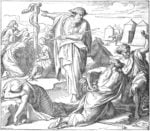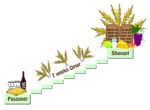
Isaac and Rebecca: Deception or Wigner’s Friend Paradox?
Synopsis The narrative of the “stolen blessings” in Parashat Toldot presents a profound moral paradox: How could Rebecca, a righteous prophetess, and Jacob, the archetype

Synopsis The narrative of the “stolen blessings” in Parashat Toldot presents a profound moral paradox: How could Rebecca, a righteous prophetess, and Jacob, the archetype

This essay explores a novel parallel between quantum mechanical principles and the biblical creation narrative through etymological analysis of the Hebrew terms “erev” (evening) and
Structurally identical biblical accounts of creation, destruction, and restoration are viewed as a manifestation of dialectic triad thesis-antithesis-synthesis.

So the present passed over before him; and he himself lodged that night in the camp. And he rose up that night, and took his

And these are the chronicles of Isaac… (Genesis 25:19) So Esau went unto Ishmael, and took unto the wives that he had Mahalath the daughter

A light shalt thou make to the ark…with lower, second, and third stories shalt thou make it. (Genesis 6:16) We mentioned in the previous posts

A Study in Form and Matter And Moses prayed for the people. And the Eternal said unto Moses: “Make thee a fiery serpent, and set it

There is a Biblical Commandment to count the days between the Passover and Shavuot, the “Feast of Weeks” (a.k.a. Pentecost). We start counting on the

As we discussed in the earlier post, The Tree of Knowledge as a Metaphor for Superposition of States and Heisenberg’s Uncertainty Principle, the Heisenberg uncertainty
And the messengers returned to Jacob, saying: “We came to thy brother Esau, and moreover he cometh to meet thee, and four hundred men with

And the messengers returned to Jacob, saying: “We came to thy brother Esau, and moreover he cometh to meet thee, and four hundred men with

Synopsis This essay reads Jacob’s agreement with Laban over the streaked, speckled, and spotted sheep as far more than an odd detail in an ancient
On Seder night we drink four cups of wine and eat three matzoth. Why four cups and not three? Why three matzoth and not four?